Introducing Workout Levels: A New Way to Understand A Workout’s Difficulty
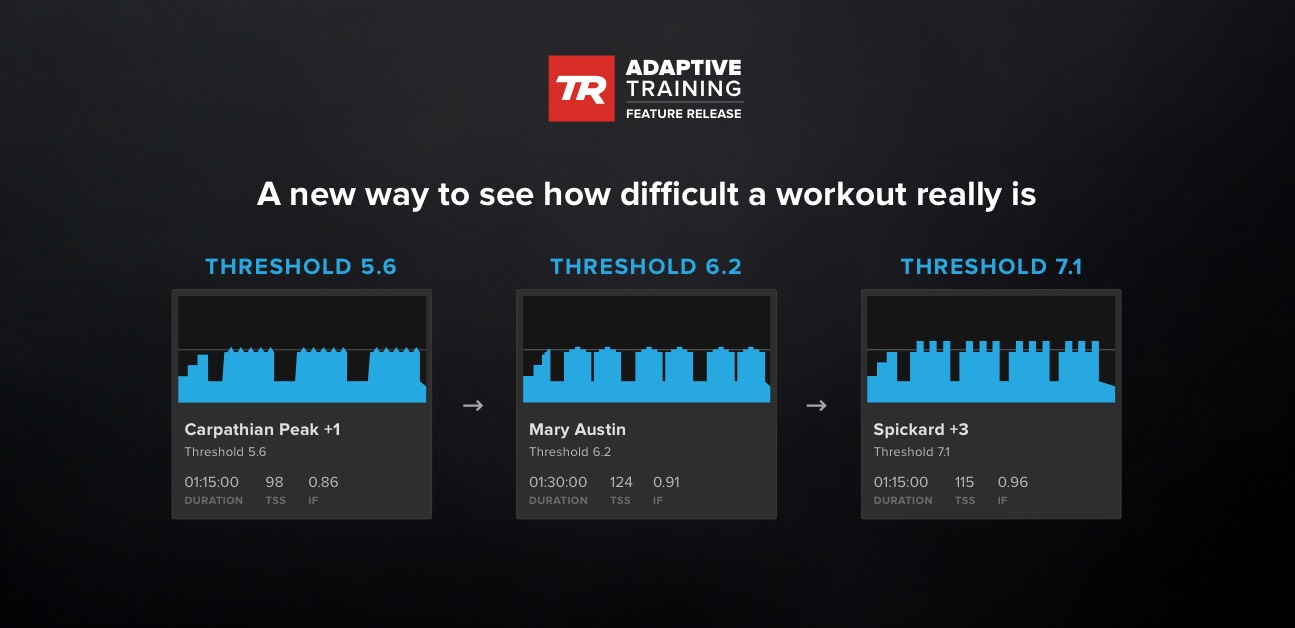
Sometimes, a workout can take you by surprise. Even with metrics like TSS, IF, and detailed descriptions, some workouts still turn out to be easier or more difficult than you expect. That’s why we’re introducing Workout Levels– a new way of easily comparing the difficulty of workouts, so you can make more informed choices in your training.
What Are Workout Levels?
Workout Levels are a new metric in TrainerRoad that compares the relative difficulty of workouts within each energy system and its corresponding training zone. They range from 1 to 10, with 1 being easiest and 10 being the hardest. Thus, a Level 6 Threshold workout is significantly harder than a Level 3 Threshold workout, but not as challenging as a Level 9 threshold workout. A very few particularly challenging workouts even exceed Level 10, but these aren’t for the faint of heart.
Workout Levels go beyond metrics that only tell part of the story, like Training Stress Score (TSS) and Intensity Factor (IF). Instead, they utilize Adaptive Training’s data-driven insights and incorporate nuanced factors such as repetition, interval length, and recovery time. The end result is a ranking of workout difficulty that is both easily understandable and based in real-world experience.
Adaptive Training
Get the right workout, every time with training that adapts to you.
Check Out TrainerRoadMore Revealing Than Other Metrics
TSS, IF, Duration, and kJ(cal) are crucial metrics for understanding the impact of each workout, but none of them tells the full story. For instance, long, slow rides can have the same TSS and kJ(cal) as short, more intense ones. Also, two workouts of the same length and IF may have vastly different work/recovery structures, making it hard to compare the experience of one to the other. Workout Levels take all these factors into account in one easily understandable metric.
Similarly, Workout Levels give you insight into your strengths because they’re based on individual energy systems and training zones. For example, let’s consider a cyclist that’s just finished base training. During base training, the vast majority of training is focused on building aerobic fitness and muscular endurance, with little attention on the high power efforts. In this case, you can expect this cyclist to find a Level 6 Endurance workout to feel easy, but a Level 6 Anaerobic workout to be a challenge.
Where Are Workout Levels Displayed?
Workout Levels are displayed anywhere you see other workout information within TrainerRoad, alongside information such as duration, TSS, and IF. This includes on the Calendar, within training plans, and on the detailed information pages for each workout.
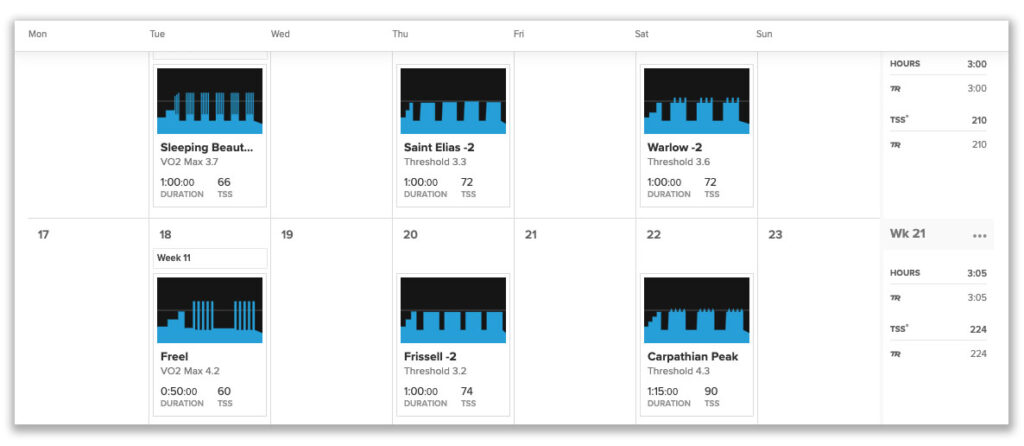
Workout Levels include a training zone along with a numerical difficulty ranking. This is important because workout levels are only meant to compare workouts within the same zone- for instance, a level 5 Endurance workout is not comparable to a level 5 VO2 Max or Threshold workout.
Difficulty Levels
Difficulty Levels are a subjective assessment of how hard a workout may feel for you to complete. Difficulty Levels are created by comparing a workout’s Workout Level to your Progression Level in the workout’s primary training zone. You can use Difficulty Levels when searching for workouts. There are four levels: Achievable, Productive, Stretch, and Breakthrough.
Difficulty Levels Explained
- Achievable
Achievable workouts are where the Workout level is below your Progression Level and are comparatively easier because the Workout Level is less than your current Progression Level. - Productive
Productive workouts are at or just above your Progression Level. They’re great for consistency, maintaining the balance between growing your fitness and not overloading yourself with too much. - Stretch
Stretch workouts are further above your Progression Level than a Productive one and will be tough in relation to your current fitness. While doable, they are challenging to do consistently and require additional focus on recovery. - Breakthrough
Breakthrough workouts are even higher than your Progression Level than a stretch one, meaning that successfully completing a workout of this type will be very difficult.
How do Workout Levels Improve Your Training?
Workout levels are a powerful and practical way to understand your training with more nuance than other metrics provide on their own. Whether Workout levels are a powerful and practical way to understand your training with more nuance than other metrics provide on their own. Additionally, Adaptive Training uses them to ensure that every workout matches your abilities and goals. However you train, workout levels can help make you faster.
Workout Levels in Training Plans
All of TrainerRoad’s training plans use Workout Levels to ensure they are progressive and sustainable.
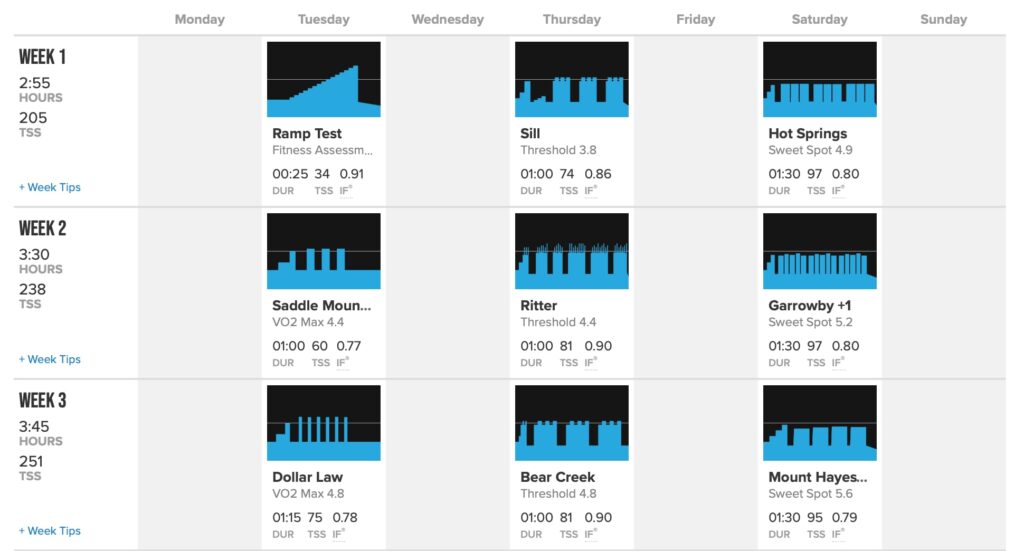
Sustained Power Build (Low Volume) offers an example of how this works. The first Sweet Spot workout in this plan is Hot Springs, which is Level 4.9 and 97 TSS. A week later, the plan includes Garrowby +1 (Level 5.2, 97 TSS), and a week after that Mount Hayes -3 (Level 5.61, 95 TSS).
Based on TSS alone it might look like these workouts get successively easier. However, their structure of work and recovery intervals means each is a bit more challenging than the last, and using Workout Levels to place them in succession allows a natural progression from week to week. Workouts in all training zones are arranged in a similar order throughout TrainerRoad training plans.
Workout Levels in Adaptive Training
With Adaptive Training, Workout Levels allow already-progressive training plans to continually adjust in response to your progress, so you get the most effective training for your goals.
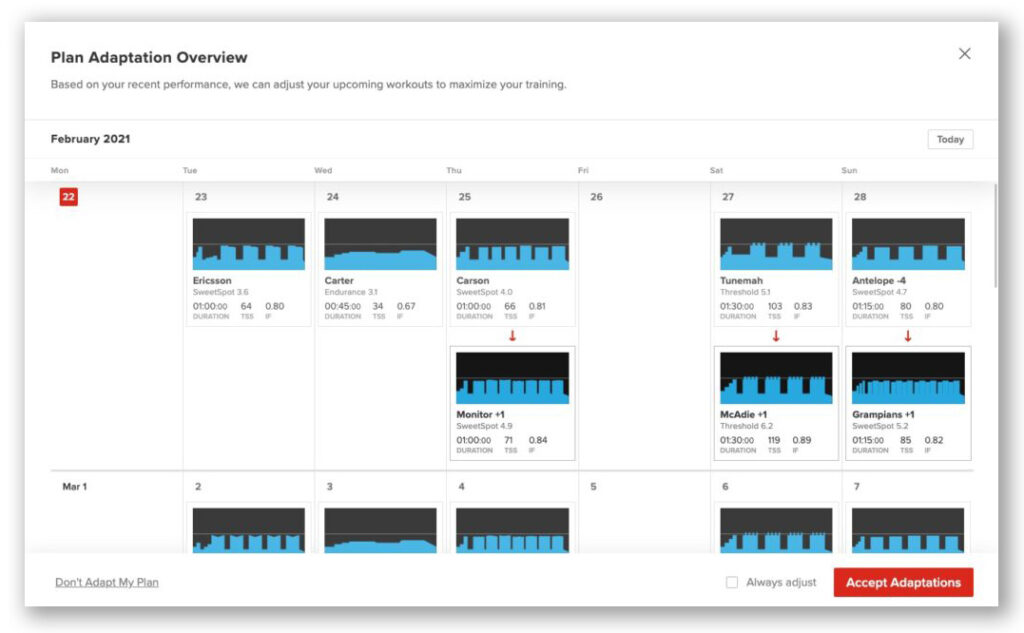
Each time you complete a workout, your Progression Level in the workout’s zone adjusts in response. Adaptive Training then assesses the Workout Levels of your upcoming workouts to ensure they’re still in line with your current abilities. Sometimes, workouts in your training plan will be replaced with workouts at a Workout Level slightly higher than your Progression Level. These workouts will be challenging and are meant to push your limits. Meanwhile, sometimes workouts are replaced with sessions that are intentionally a little below your capabilities; these workouts are meant to maintain your fitness without adding too much extra fatigue or stress.
Choosing Individual Workouts
There are more than 3,000 workouts to choose from within TrainerRoad, with more added all the time. So even if you have a duration and training zone in mind, it can still be a daunting task to pick one suited to your abilities.
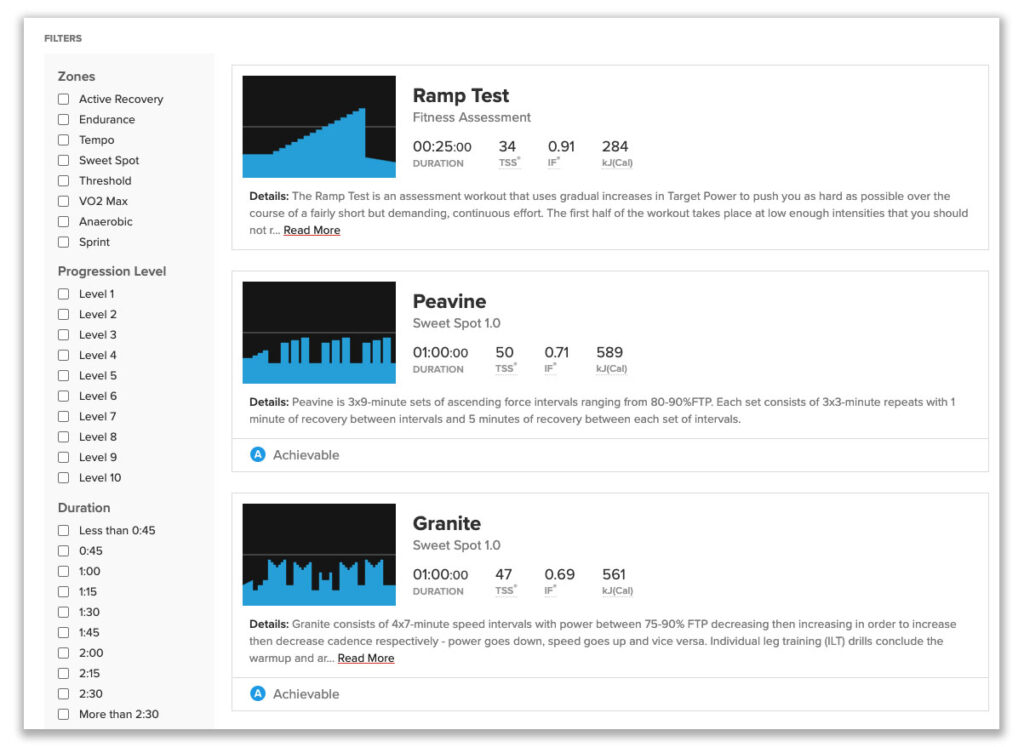
Workout Levels help make the choice easier. You can use the Workout Level filter in the workout menu to narrow down your search to workouts within the desired range. For even more personalized selections, the Difficulty filter allows you to sort workouts by how hard they’ll be in comparison to your actual abilities.
Workouts are always presented in order of Workout Level, so you see an easiest to hardest range no matter what other filters you’ve applied. This way, even if your options include workouts of similar durations and interval structures, it’s easy to compare their relative difficulty and decide which one suits you best.
Frequently Asked Questions
What are Workout Levels?
Workout levels are a new metric in TrainerRoad that compares the relative difficulty of workouts within each energy system and training zone. They range from 1 to 10 with some workouts even exceeding a level 10, with 1 representing an easy workout. Thus, a Level 6 Threshold workout is significantly harder than a Level 3 Threshold workout, but not as challenging as a Level 9 threshold workout.
How did you come up with them?
We leveraged the analysis made possible by our Machine Learning algorithms and the insights we have gained with Adaptive Training to accurately quantify the difficulty of any workout. The result is a very accurate representation of workout difficulty that takes into account details such as interval repetition, interval length, interval format, recovery time, and more.
What are Difficulty Levels?
Difficulty Levels are a comparison of a workout’s Workout Level with your Progression Level in that workout’s training zone. In effect, it’s a subjective rating of how difficult the workout is likely to be, based on your current abilities and fitness. There are five difficulty levels: Achievable, Productive, Stretch, Breakthrough, and Not Recommended.
How are these different from my individual Progression Levels I’ve seen in the Adaptive Training previews?
Your individual Progression Levels are a representation of your capabilities, based on the Workout Levels of the workouts you’ve recently completed and on how challenging they were for you to complete.
Are Workout Levels comparable from one Zone to another?
No. Workout Levels are classified in two ways: (1) Zone (2) Workout Profile. An example of Zones would be Endurance, Tempo, Sweet Spot, Threshold, VO2 Max, Anaerobic, Sprint. Each Zone has various different Workout Profiles within it. Workout Profiles represent the interval structure of the workout. For example, the VO2 Max Zone has On-Offs, Float Sets, Sustained Intervals, Traditional, Attacks, and more.
Workout Levels within a specific Zone and Workout Profile can be directly compared, while Workout Levels within a specific Zone but different Workout Profiles can only be loosely compared. Workout Levels between workouts of different Zones cannot be compared. For example, a Threshold Level 4.0 and an Endurance 4.0 are not going to have the same RPE.
What is the max level?
There is no max level, but most workouts will fall within Workout Levels 1-10. If you are completing workouts above Workout Level 10, you are likely to gain more from reassessing and starting a new training plan at a higher FTP and lower Workout Levels.
How do I know how hard a workout is with these Workout Levels?
Difficulty Levels make it easy to estimate how challenging a workout will be. For instance, workouts marked as Achievable will be comparatively easy to complete. Productive workouts will be more challenging, but you can probably complete them if you set your mind to it. Workouts marked Stretch or Breakthrough will be much more challenging, and are likely to leave you quite exhausted. Finally, workouts marked Not Recommended are so far above your current level that they’re usually unproductive to even attempt.
The Difficulty level displayed for each workout depends on your current abilities, but the numerical Workout Level never changes and is determined by the workout itself. For context, most athletes are able to complete Level 3 workouts regardless of where they’re at in their training, while significantly fewer athletes tend to successfully complete Level 8 workouts unless their training has properly progressed them to that point.
Are Workout Levels personalized to each athlete?
No. Workout Levels are assigned to a specific workout based on it’s difficulty, and is done regardless of an athlete’s abilities. Individual Progression Levels, an upcoming and currently unreleased feature, is what will be unique to each athlete.
Will my custom workouts have Workout Levels?
Yes, all TrainerRoad workouts and custom workouts should have Workout Levels assigned to them, but at this point, we can’t endorse the Workout Levels of custom workouts. As of now, Workout Levels are calculated uniquely for custom workouts and are not comparable to the Workout Levels of workouts in the TrainerRoad workout library.
Will Outside Workouts have Workout Levels?
Yes. Every Outside Workout in the TrainerRoad workout library will have Workout Levels assigned to them.
How should I use this in conjunction with TSS and IF?
TSS, IF, Duration, and kJ(cal) are crucial metrics for understanding the impact of each workout, but none of them tells the full story. For instance, long, slow rides can have the same TSS and kJ(cal) as short, more intense ones. Also, two workouts of the same length and IF may have vastly different work/recovery structures, making it hard to compare the experience of one to the other. Workout Levels take all these factors into account in one easily understandable metric.